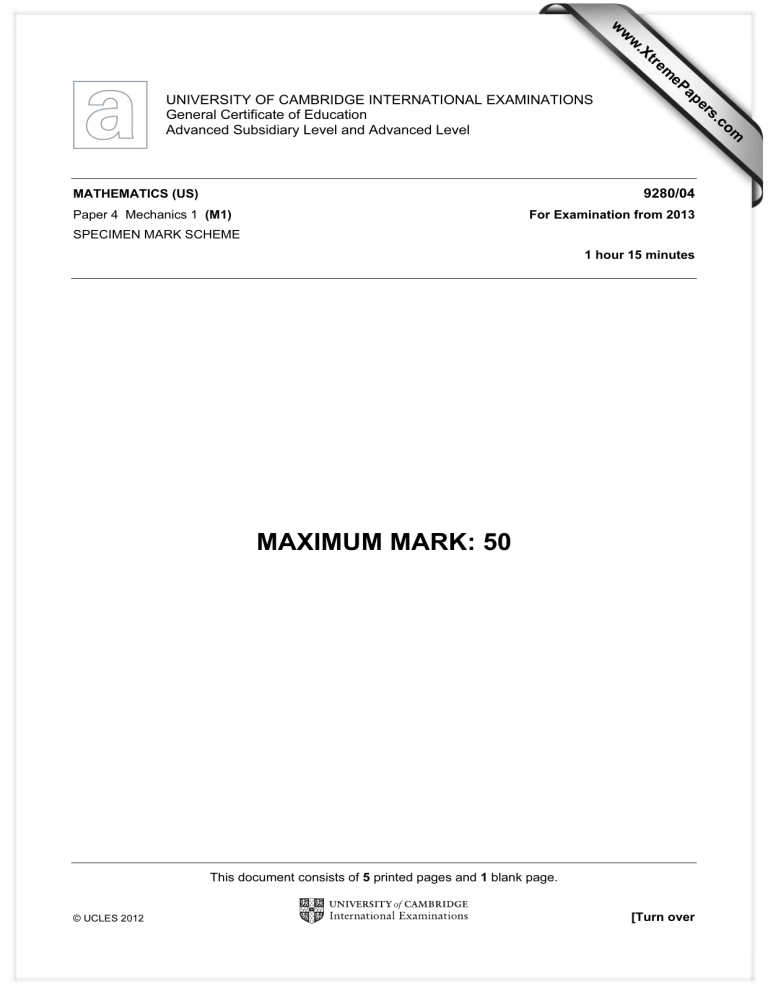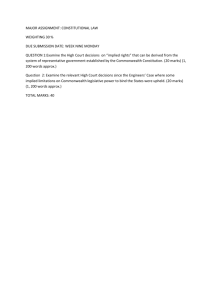www.XtremePapers.com

www.XtremePapers.com
UNIVERSITY OF CAMBRIDGE INTERNATIONAL EXAMINATIONS
General Certificate of Education
Advanced Subsidiary Level and Advanced Level
MATHEMATICS (US)
Paper 4 Mechanics 1 (M1)
SPECIMEN MARK SCHEME
9280/04
For Examination from 2013
1 hour 15 minutes
MAXIMUM MARK: 50
© UCLES 2012
This document consists of 5 printed pages and 1 blank page.
[Turn over
2
Mark Scheme Notes
Marks are of the following three types:
M Method mark, awarded for a valid method applied to the problem. Method marks are not lost for numerical errors, algebraic slips, or errors in units. However, it is not usually sufficient for a candidate just to indicate an intention of using some method or just to quote a formula; the formula or idea must be applied to the specific problem in hand, e.g., by substituting the relevant quantities into the formula. Correct application of a formula without the formula being quoted obviously earns the M mark and in some cases an M mark can be implied from a correct answer.
A Accuracy mark, awarded for a correct answer or intermediate step correctly obtained.
Accuracy marks cannot be given unless the associated method mark is earned (or implied).
B Mark for a correct result or statement independent of method marks.
• When a part of a question has two or more “method” steps, the M marks are generally independent unless the scheme specifically says otherwise; and similarly when there are several B marks allocated. The notation DM or DB (or dep*) is used to indicate that a particular M or B mark is dependent on an earlier M or B (asterisked) mark in the scheme.
When two or more steps are run together by the candidate, the earlier marks are implied and full credit is given. on from previously incorrect results. Otherwise, A or B marks are given for correct work only. A and B marks are not given for fortuitously “correct” answers or results obtained from incorrect working.
• Note: B2 or A2 means that the candidate can earn 2 or 0.
B2/1/0 means that the candidate can earn anything from 0 to 2.
The marks indicated in the scheme may not be subdivided. If there is genuine doubt whether a candidate has earned a mark, allow the candidate the benefit of the doubt. Unless otherwise indicated, marks once gained cannot subsequently be lost, e.g., wrong working following a correct form of answer is ignored.
• Wrong or missing units in an answer should not lead to the loss of a mark unless the scheme specifically indicates otherwise.
• For a numerical answer, allow the A or B mark if a value is obtained that is correct to 3 s.f., or that would be correct to 3 s.f. if rounded (1 d.p. in the case of an angle). As stated above, an A or B mark is not given if a correct numerical answer arises fortuitously from incorrect working. For Mechanics questions, allow A or B marks for correct answers that arise from taking g equal to 9.8 or 9.81 instead of 10.
© UCLES 2013 9280/04/SM/13
3
The following abbreviations may be used in a mark scheme or used on the scripts:
AEF
AG
Any Equivalent Form (of answer is equally acceptable)
Answer Given on the question paper (so extra checking is needed to ensure that the detailed working leading to the result is valid)
BOD Benefit of Doubt (allowed when the validity of a solution may not be absolutely clear)
CAO Correct Answer Only (emphasizing that no “follow through” from a previous error is allowed)
CWO Correct Working Only often written by a “fortuitous” answer
ISW Ignore Subsequent Working
MR
PA
Misread
Premature Approximation (resulting in basically correct work that is insufficiently accurate)
SOS
SR
See Other Solution (the candidate makes a better attempt at the same question)
Special Ruling (detailing the mark to be given for a specific wrong solution, or a case where some standard marking practice is to be varied in the light of a particular circumstance)
Penalties
MR –1 A penalty of MR –1 is deducted from A or B marks when the data of a question or part question are genuinely misread and the object and difficulty of the question remain unaltered. In this case all A and B marks then become “follow through √”
PA –1 This is deducted from A or B marks in the case of premature approximation. The
PA –1 penalty is usually discussed at the meeting. marks. MR is not applied when the candidate misreads their own figures – this is regarded as an error in accuracy. An MR –2 penalty may be applied in particular cases if agreed at the coordination meeting.
© UCLES 2013 9280/04/SM/13
[Turn over
4
1 (i)
[DF – 600 = 700 × 2] M1 For using Newton’s second law (3 terms needed)
Driving force is 2000 N
(ii)
[P = 2000 × 15]
Rate of working is 30000 W (or 30 kW) A1 [2]
2 (i)
Gain in PE = 1250g × 1.54 ( = 19250 J) B1
[WD = 1250g × 1.54 + 5750]
A1
M1
[2]
For using P = Fv
M1 For using WD by crane = Gain in PE +
WD against resistance
Work done is 25000 J (or 25 kJ)
(ii)
[1250 = 25000 / T]
A1
M1
[3] for using P =
∆
(WD) /
∆ t
Time is 20 s A1 [2] Ans (i) ÷ 1250
3 M1 vertically (3 terms needed)
Tcos
θ
+ Tsin
θ
= 15.5
–Tcos
θ
+ Tsin
θ
= 8.5
Tsin
θ
= 12 and Tcos
θ
= 3.5
θ
= 73.7
o
(or 1.29 radians)
4 (i)
A1
A1
DM1
A1
B1
For solving for Tsin
[6]
AG
θ
and Tcos
θ
M1
AEF
AEF
For resolving forces parallel to the plane
(either case) – 3 terms needed
2X + F = 11gsin30
9X – F = 11gsin30 o o
and
X = 10
(ii)
F = 35
R = 11gcos30 o
Coefficient is 0.367
5 (i) v(600) = 0.025 × 600
A1
A1
B1
[3]
May be implied.
B1
A1 [4]
B1
0 = 15 – 0.0375t
3
Total time is 3600 s
(ii) For correct graph
1
2
2
(2600 + 3600) × 15 or
2
0.025 × 600
2
0.0375 × 400
2
]
+ 2600 × 15 +
Distance is 46500
(iii)
Values of t are 300 and 3400
A1
A1
M1
A1
[4]
0 = v(600 + 2600) – 0.0375t
3
and v(600 + 2600) = v(600)
Shape only
For method of finding distance
A1 [3]
B1
[1]
© UCLES 2013 9280/04/SM/13
5
6 (i) s = 2t
2
– t
[t
4
– 128t
2
(t
2
– 64)
2
4
/64 (+ C)
+ 64
2
= 0]
= 0
Time taken is 8 s
M1 For using s =
∫
v d t
A1
M1
A1
A1
[5]
For attempting to solve s(t) = 64
(ii) M1 For using a = dv/dt a = 4 – 3t
2
/16 A1 a is positive for 0 < t <
0 < t < 4.62
8
3
or B2 [4] SR: Allow B1 for t <
SR: B1 for 0 ≤ t ≤
8
3
8
3
or 4.62
7 (i)
M1 For applying Newton’s second law to A or to B
T – 12 = 1.2a and 20 –T = 2a
Acceleration is 2.5 ms
Tension is 15 N
-2
(ii) (a)
PE gain = 12 × 1.5 = 18 J
(b) WD on A = 15 × 1.5 = 22.5J
(c) Gain in KE = ans (b) – ans (a) = 4.5 J
A1
B1
A1 [4]
B1
B1
B1 [3] alt: KE =
1
2
1.2(2 × 2.5 × 1.5) = 4.5J
B1
Accept (2 – 1.2)g = (2.0 + 1.2)a as an alternative for one of these equations
(iii)
v = 1.6 × 2.5 t = 0.4 s
Total time taken is 0.8 s
A1
A1 [4]
May be implied
© UCLES 2013 9280/04/SM/13
[Turn over
6
BLANK PAGE
© UCLES 2013 9280/04/SM/13








